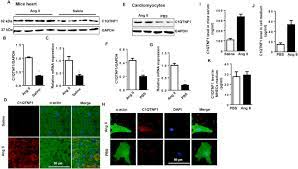C1QTNF1 attenuates angiotensin
Complement tumor necrosis factor C1q (C1QTNF)-related proteins have been reported to have a diverse biological influence on the cardiovascular system. C1QTNF1 is part of the CTRP superfamily. C1QTNF1 is expressed in the myocardium; however, its function in myocytes has not yet been studied.
To systematically investigate the roles of C1QTNF1 in angiotensin II (Ang II)-induced cardiac hypertrophy.
C1QTNF1 knockout mice were used to determine the role of C1QTNF1 in cardiac hypertrophy in the adult heart. Data from the experiments showed that C1QTNF1 was up-regulated during cardiac hypertrophic processes, which were triggered by increased reactive oxygen species.
C1QTNF1 deficiency accelerated cardiac hypertrophy, fibrosis, inflammatory responses, and oxidative stress with worsening cardiac dysfunction in the mouse model of Ang II-induced cardiac hypertrophy.

We identified C1QTNF1 as a negative regulator of cardiomyocyte hypertrophy in Ang II-stimulated newborn rat cardiomyocytes using the recombinant human globular domain of C1QTNF1 and C1QTNF1 siRNA. Injection of the recombinant human globular domain of C1QTNF1 also suppressed the Ang II-induced cardiac hypertrophic response in vivo.
The anti-hypertrophic effects of C1QTNF1 are based on the activation of AMPKa, which inhibits the phosphorylation of mTOR P70S6K. An AMPKa inhibitor abolished the anti-hypertrophic effects of the recombinant human globular domain of C1QTNF1 both in vivo and in vitro. Additionally, C1QTNF1-mediated AMPKa activation was triggered by PDE1-4 inhibition, which then activated the cAMP/PKA/LKB1 pathway.
Our results demonstrated that C1QTNF1 improves cardiac function and inhibits cardiac enlargement and fibrosis by increasing and activating AMPKa, suggesting that C1QTNF1 could be a therapeutic target for cardiac enlargement and heart failure.
Downregulation of C1QTNF1-AS1 suppresses tumor growth in vivo. (A) Representative images of tumor xenografts formed from SW480 cells stably expressing sh-C1QTNF1-AS1 or sh-NC. (B) Growth curves were plotted against recorded tumor volumes (Student's t-test). Each group contained three nude mice.
(C) Weights of tumor xenografts were detected (Student's t-test). Each group contained three nude mice. (D and E) RT-qPCR revealed expression of C1QTNF1-AS1 and miR-484 in tumor xenografts derived from stably transfected sh-C1QTNF1-AS1 or sh-NC SW480 cells (Student's t-test) . Each group contained three nude mice.
Each sample contained three replicates and the RT-qPCR was repeated three times. (F) Protein level of HK2 in tumor xenografts was determined using Western blot (Student's t-test). Each group contained three nude mice. Western blot was repeated three times. **P<0.01. Abbreviations: HK-2, hexokinase 2; GAPDH, glyceraldehyde 3-phosphate dehydrogenase.
C1QTNF1-AS1, C1QTNF1 antisense RNA 1; sh-C1QTNF1-AS1, short hairpin RNA targeting C1QTNF1-AS1; sh-NC, negative control short hairpin RNA; miR-484, microRNA-484.
